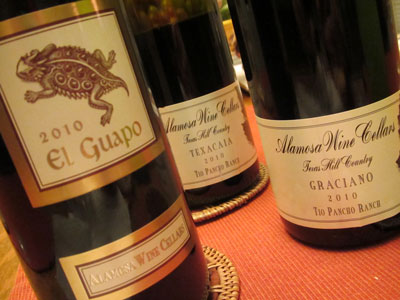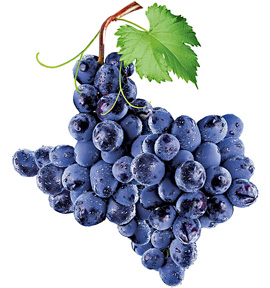Old World Charm, New World Adventure – The Wines of Alamosa Wine Cellars
The other day, after tasting a set of three wines from Alamosa Wine Cellars, I was reading in my Sotherby’s Wine Encyclopedia…
“While Spain can claim a 3,000 year history of wine, the diversity of its wine areas and styles did not commence until the 1490’s, just 30 years before the Spanish planted the first vines in the Americans. Some parts of the Old and New Worlds are much closer in age… than these terms imply.”
Well, Texas can claim a wine history that goes back to the 1600s, only 150 years after the entry of Spanish vines into the Americas and nearly 100 years before the arrival of Old World vines in California. Texas owes its wine genesis to the Spanish that settled in what then were the northern borderlands of Mexico (called Tejas) at El Paso del Norte.
Why do I bring up this lengthy preamble to my tasting notes of these particular wines? It’s precisely because Texas, more than any other of the largest wine producing American states – CA, WA, NY, OR), has a linkage to Old World wines. It’s rooted in its limestone encrusted terroir and fiery summer climate akin to that of Europe’s Mediterranean region that takes in Spain, southern France and Italy. From the get-go, Alamosa Wine Cellars has focused on this heritage: Mediterranean grape varieties with a Chardonnay vine nowhere in sight!
According to Jim Johnson (Owner, grape grower and winemaker at Alamosa Wine Cellars), “Our vineyard was planted in stages. In ‘96 we planted Sangiovese, Viognier, Ruby Cabernet, and Cabernet Sauvignon. In ’98 it was Tempranillo, Grenache, and Syrah. In ‘99 we included Syrah, Mourvedre and Malvasia Bianca. Of those, the Ruby Cab, Cab Sauv, Mourvedre and Malvasia are gone. I just couldn’t get the Cabs to grow well, Mourvedre was hypersensitive to Pierce’s Disease, and Malvasia is thin skinned and rotty in our climate. To the remaining varieties, over the years, we have added Graciano, Tannat, Verdelho and Petite Verdot.”
As you can plainly see, he’s focused completely on the Tex-Med wine experience, but it doesn’t end there. I took three red wines from Alamosa Wine Cellars with me on a recent trip to Fredericksburg, Texas, to taste with friend and fellow wine and culinary author Chef Terry Thompson Anderson and her husband Roger. The following notes are an amalgamation of our comments.
The tasting started with Alamosa Wine Cellars 2010 El Guapo, a Spanish red-blend (72% Tempranillo, 20% Graciano and 5% Garancha with 13.4% alcohol). The wine had a deep red garnet color that offered red berry and plum aromas combined with a hint of aromatic tobacco and stony mineral characteristics. On the palate, it generally followed the aroma with red and black berries dominating over dry (still tight) tannins and a medium+ lingering note of dusty earth on the finish. This wine had an excellent Old World presence similar in style and finesse to a classic Spanish Rioja Alta (possibly a disappointment for those looking for just another California-style fruit bomb), but a true find for those looking for “Wines of Terroir”.
To these notes, Jim added, “My approach to winemaking is definitely old world with minimal intervention. At Alamosa, we shoot for good harvest chemistry, but will adjust in the winery as required. We go for ripe flavors and use new oak sparingly. Our approach to blending is to use blends for most of our reds and, in old world tradition, field blend when possible. A good wine is like a good book, it needs a beginning, middle, and finish. I believe that blending is a good way to achieve that objective, particularly when using warm climate grapes.” On this latter point, Jim is spot on: most warm wine producing regions are best known for their blended wines, not for making single varietal wines.
The second wine up was the Alamosa 2010 Graciano. Alamosa Wine Cellars is perhaps the only winery in Texas with enough Graciano vines growing to make both a blended wine (El Guapo) and a single varietal wine from this grape variety. Graciano is a red blending grape of particular noteworthiness in Spain’s Rioja region normally associated with wines made from its leading grape: Tempranillo. In fact, most Spanish Rioja wines are blends that support its “all-star” Tempranillo with Granacha (Granache) for color, body and alcohol, and Graciano for acidity, flavor and aroma, and don’t forget Mazuelo for tannin and ageing characteristics. Alamosa’s Graciano showed a distinctive varietal character strong with black cherry on the nose and palate and a dominant sweet Cavendish tobacco aroma (the likely source for the sweet tobacco in the El Guapo) that opened further into scents of humus. It was apparent why Garciano has its appeal as a blending grape that marries well with Tempranillo and plays a role in making of true Rioja-style wines.
In preparing for this tasting, I asked Jim what were the top three challenges he has experienced making TexMed wines with exotic grape names. He prioritized them and said, “Number 1 – Lack of name recognition in the marketplace for some of the varieties that work well for us. Number 2 – Weather related challenges, spring frosts, high temps at harvest, rain at inconvenient times, and Number 3 – Weeds! The grand prize goes to Johnson Grass with the reserve grand champion going to Texas Sandbur, more commonly known as Goatheads. Number 4 – Last but not least, it’s rattlesnakes. Dogs can now be vaccinated against rattlesnake bites (not everybody knows this) and ours are, and for good reason!”
The third wine for the evening was Jim’s eclectic red blend, Alamosa 2010 Texacaia (pronounced “Tex-a-ki-ya”), single vineyard designated with the name of his estate vineyard (Tio Pancho Ranch). On the side of the bottle, it says that it is 64% Sangiovese (from the Tuscan region of Italy), 15% Tannat (a tannic grape that makes nearly black wine originating from the Spanish Basque area and most commonly found in the Pyrenees regions of Spain and France) and 11% Petit Verdot (a red blending grape from used in Bordeaux to add acidity and spicy notes). This is a wine that both defines and fulfills Jim’s mission for TexMed wines, all 360 points of the region’s compass.
The Texacaia had a deep red purple color that held a garnet hue when angled just right that held aromas of red fruit on the attack followed by scents dark plums and new leather. On the palate, the red/dark fruits held true to the aroma tailing toward a mouthfeel dominated by tannins reminiscent of hazelnuts (Terry focused on hazelnut skins), and completed with a dry, minerally finish with a cool, cool 13.1% alcohol.
In reflection, Jim has a feel for the future of Texas wines. He said, “In ten years, if we do it right, there will be more Mediterranean grape varieties grown here in Texas, almost no Burgundian varietals like Chardonnay and Pinot Noir. There will be more wineries, probably double what we have today. Most of all, there will be better consumer acceptance in the marketplace of what may appear today as exotic and mysterious Mediterranean grape varieties and wine names. I’m surely counting on that! After consulting my crystal ball, I say that there might even be a Texas-based cooperage making wine and whiskey barrels from Missouri, Minnesota, and Pennsylvania oak.”
All in all, these wines of Alamosa Wine Cellars highlighted the Old World linkage of the Lone Star State while conveying the spirit of adventure that is helping to define the Texas wine experience of today and the future. They offered medium+ body and concentration, pleasantly moderate alcohol levels, and most of all, the mineral character that heretofore has been only associated with Old World wines.




Be the first to comment